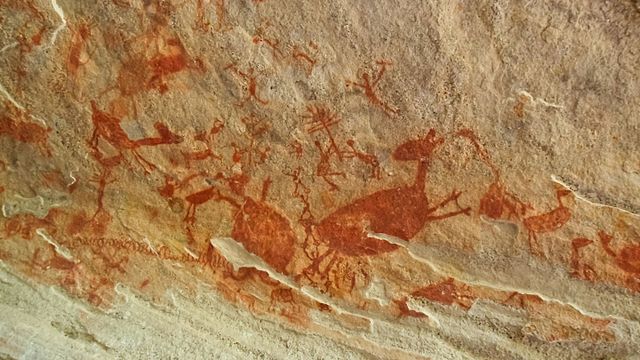Serra da Capivara – Brazil: Cradle of the Earliest Americans and Sacred Rock Art
The Serra da Capivara National Park, located in the semi-arid caatinga region of Piauí, northeastern Brazil, is home to one of the richest and most significant concentrations of prehistoric rock art in the world. This archaeological sanctuary preserves thousands of painted and engraved rock shelters, some of which date back more than 25,000 years, potentially rewriting the narrative of human settlement in the Americas.
Roger Swidorowicz
5/26/20253 min read


Serra da Capivara – Brazil: Cradle of the Earliest Americans and Sacred Rock Art
Introduction
The Serra da Capivara National Park, located in the semi-arid caatinga region of Piauí, northeastern Brazil, is home to one of the richest and most significant concentrations of prehistoric rock art in the world. This archaeological sanctuary preserves thousands of painted and engraved rock shelters, some of which date back more than 25,000 years, potentially rewriting the narrative of human settlement in the Americas.
Designated a UNESCO World Heritage Site in 1991, Serra da Capivara stands as a monument not only to early human life but to cultural endurance, artistic expression, and sacred tradition. Its imagery—ranging from animals and humans to geometric patterns and ritual scenes—provides a visual archive of prehistoric life in South America.
Discovery and Archaeological Importance
The park gained international attention thanks to the tireless work of Brazilian-French archaeologist Niède Guidon, who began systematic excavations in the 1970s. Her findings at sites such as Boqueirão da Pedra Furada challenged the long-standing Clovis-first model of American colonization.
Charcoal remains, tools, hearths, and cave paintings found in stratified layers suggest human presence as early as 30,000 years ago, a controversial hypothesis that sparked global debate. Whether or not these early dates are accepted, the cultural richness and continuity at Serra da Capivara remain indisputable.
Geographical and Ecological Context
Serra da Capivara spans more than 129,000 hectares, encompassing canyons, plateaus, rock formations, and vegetation adapted to arid conditions. The rock shelters are typically located in protected sandstone escarpments, where prehistoric people found refuge and water sources.
This integration of environment and habitation allowed for long-term occupation, as evidenced by the extensive layers of cultural debris, hearths, and faunal remains. The site’s ecological diversity also contributed to a wide array of faunal depictions in the rock art.
Themes and Iconography
The art in Serra da Capivara consists of tens of thousands of images, painted mostly in red, but also in yellow, white, and black. Subjects include:
Faunal figures: Jaguars, deer, capybaras, armadillos, monkeys, and birds
Human activities: Dancing, hunting, fighting, giving birth, and communal rituals
Abstract forms: Geometric patterns, dotted lines, zigzags, and enigmatic signs
These compositions are frequently organized in narrative scenes, often with a high degree of motion and interaction. Some of the panels include up to 100 figures in complex arrangements.
Techniques and Materials
The pigments were derived from mineral sources, including:
Iron oxides (red and yellow)
Charcoal (black)
Kaolin or lime (white)
Paint was applied using brushes made from plant fibers, fingers, or feather tools. The artists skillfully adapted the natural rock surfaces, incorporating textures and contours to enhance the visual impact of their compositions.
The durability of the pigments and the natural protection of the shelters have contributed to the excellent preservation of many artworks despite millennia of exposure.
Chronology and Phases of Occupation
While precise dating remains complex, archaeological and stylistic analyses suggest at least four major chronological phases of artistic production:
Oldest phase (25,000–12,000 BP): Characterized by linear humans and schematic fauna
Classic phase (12,000–6,000 BP): Rich narrative compositions with dynamic figures
Late phase (6,000–2,000 BP): Emphasis on abstract motifs and symbolic expression
Protohistoric phase: Linked to indigenous groups at the time of European contact
This sequence points to a continuous cultural occupation, evolving in symbolism, technique, and social function.
Ritual and Symbolic Interpretations
Interpretations of the art highlight its potential use in:
Initiation rites and fertility ceremonies
Mythic storytelling and ancestral worship
Hunting magic and territorial demarcation
The presence of birth scenes, trance-like figures, and masked dancers supports the idea of shamanic or religious purposes. The integration of landscape and cosmology suggests that the shelters functioned as sacred spaces—portals between the physical and spiritual worlds.
UNESCO Recognition and Conservation Efforts
UNESCO designated Serra da Capivara a World Heritage Site in 1991 for its exceptional testimony to early human life in the Americas. It is also protected under Brazilian federal law and managed by the FUMDHAM Foundation, directed by Niède Guidon.
Challenges to conservation include:
Funding limitations
Climate change and erosion
Encroaching agricultural development
To address these, efforts include:
Installation of protective structures
Controlled access for visitors
Digital documentation and replica creation
Educational programs and community engagement have been vital in fostering local stewardship.
Scientific and Cultural Legacy
Serra da Capivara has become a reference point for:
Debates on early human migration to the Americas
Prehistoric art studies in the Southern Hemisphere
Cultural pride and regional identity in Brazil
Its findings have reshaped global narratives and empowered regional institutions to claim their place in the human story. The park is also a model for the integration of science, conservation, and public engagement.
Conclusion
Serra da Capivara is not merely a repository of ancient images; it is a living testimony to the cognitive, artistic, and spiritual life of early South Americans. From the oldest human traces to vibrant visual storytelling, the park bridges deep time and contemporary heritage.
In a landscape shaped by erosion and memory, Serra da Capivara continues to teach, inspire, and connect us to our ancestral roots. It is both a sacred archive and a scientific beacon—reminding us that long before written language, art was our first voice.
Preserving and understanding Serra da Capivara is not only a Brazilian responsibility but a global imperative, safeguarding one of the most profound expressions of human culture ever etched into stone.
